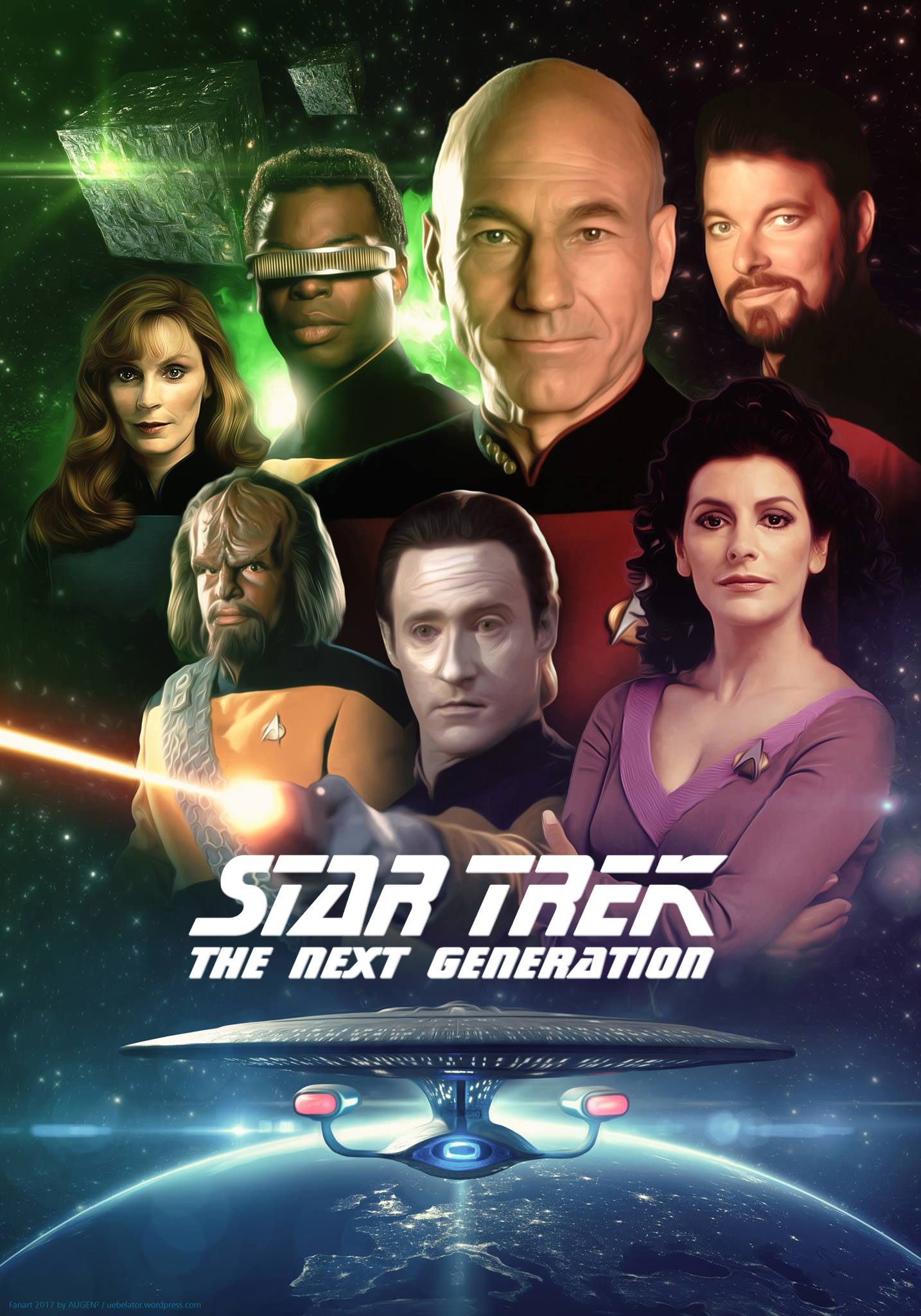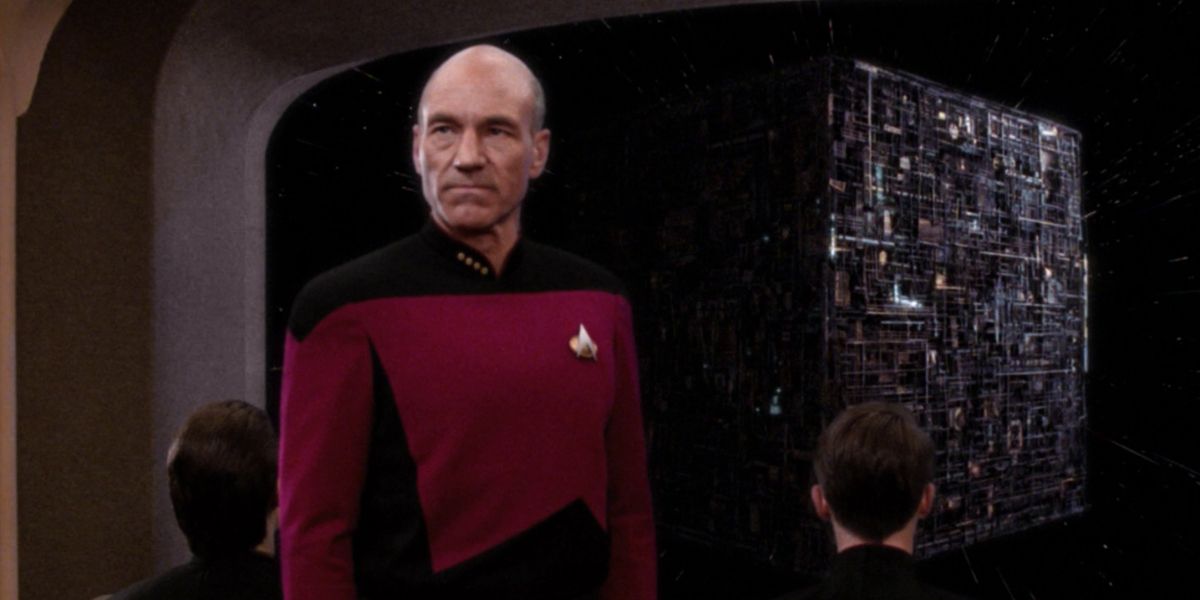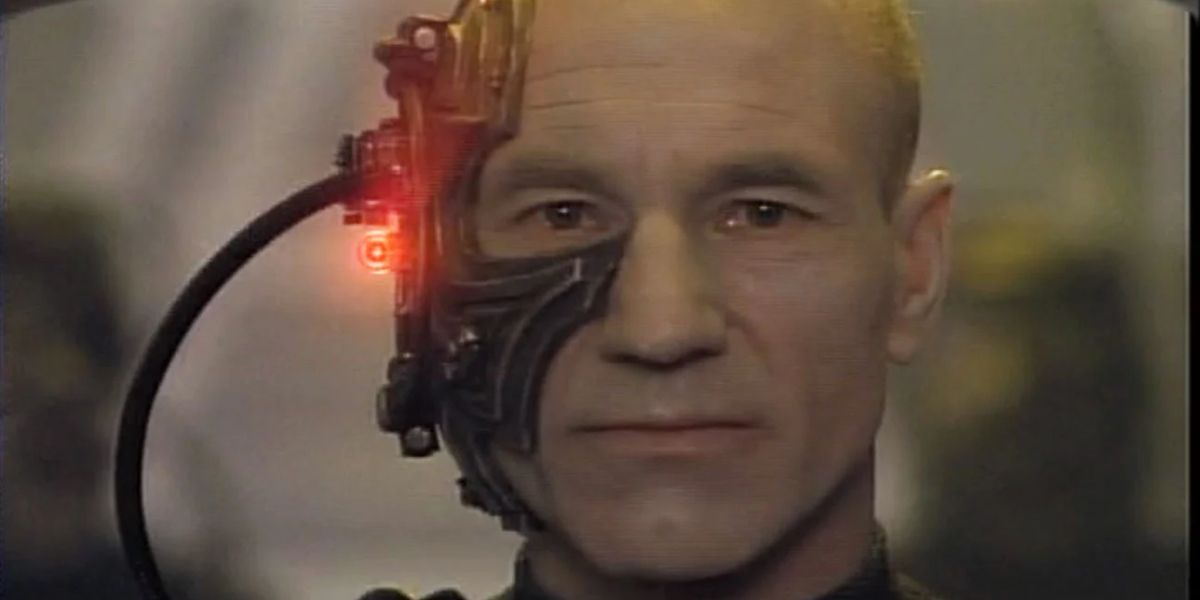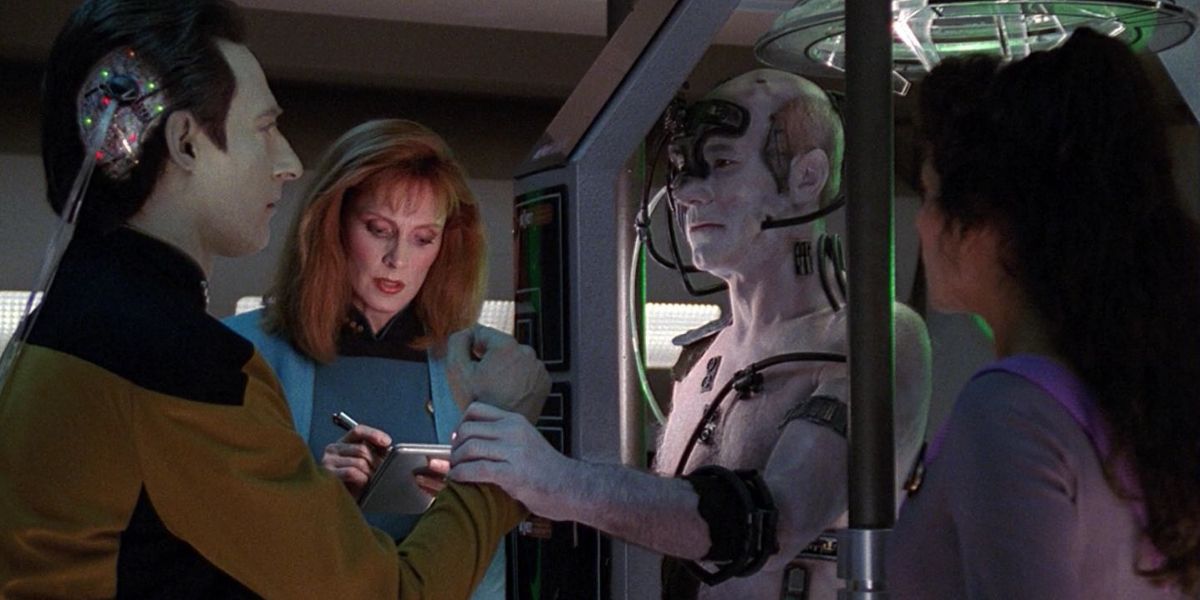
[ad_1]
The Large Image
- Serialized storytelling turned dominant in TV because of reveals like
Hill Road Blues
, which normalized season-long arcs and character improvement. -
Star Trek: The Subsequent Era
broke TV guidelines with its two-part Season 3 finale and Season 4 premiere, which launched the primary true cliffhanger and a mind-blowing twist involving the Borg. - The episodes “The Better of Each Worlds” and “Household” showcased the evolution of TV storytelling by prioritizing character improvement and exploring emotional fallout, setting a brand new normal for dramatic stress and flawed, evolving characters.
An extended, very long time in the past, one-off episodes have been the legislation of the land. Collection have been episodic in nature no matter style. Generally, characterization moments carried over and returning characters popped out and in for taste’s sake, however serialized narratives and character arcs didn’t creep into play till Eighties game-changers like Hill Road Blues. The drama from creators Steven Bochco and Michael Kozoll was a powerhouse risk-taker and an instrumental power credited for normalizing season-long arcs. Slowly however absolutely, serialized tales turned dominant sufficient that episodic reveals are actually a rarity.
Star Trek: The Subsequent Era, the floundering sequel to the Nineteen Sixties authentic, underwent an analogous evolution. The Subsequent Era already had so much to show when it hit the airwaves in 1987. The glories of syndication had turned Star Trek: The Authentic Collection right into a cult traditional, however the space-faring title was nonetheless removed from world phenomenon standing. Would the follow-up to a canceled sequence have sufficient chunk to kickstart a franchise? Eight extra reveals, 13 movies, and a thriving fandom later, the answer is a convincing sure — however not earlier than The Subsequent Era broke all of the established TV guidelines in the summertime of 1990. A intestine punch as staggeringly efficient as its affect on the franchise’s modus operandi is lasting, The Subsequent Era‘s two-part Season 3 finale and Season 4 premiere sliced up viewers expectations with the finesse of a butcher’s meat cleaver and drop-kicked the tv panorama into a brand new universe — dare we are saying, to “the place nobody has gone earlier than.”

Star Trek: The Subsequent Era
Set virtually 100 years after Captain Kirk’s 5-year mission, a brand new era of Starfleet officers units off in the united statesS. Enterprise-D by itself mission to go the place nobody has gone earlier than.
- Launch Date
- September 26, 1987
- Fundamental Style
- Sci-Fi
- Seasons
- 7
“The Better of Each Worlds” Prioritizes Character and Story Arcs
Regardless of sturdy scores, The Subsequent Era‘s early seasons noticed battle between creator Gene Roddenberry and the forged and crew over dialogue, costumes, and thematic content material. Not solely did The Subsequent Era observe the Star Trek system of one-and-done episodes, however Roddenberry was insistent humanity had advanced previous interpersonal flaws. It’s a pleasant thought, however utopian beliefs make for boring, repetitive tales. In spite of everything, battle is the guts of all drama. The extra Roddenberry stepped away from The Subsequent Era, the extra freedom the writers had to develop the Enterprise crew into dynamic, humane characters as an alternative of inventory figures fulfilling the plot-of-the-week’s necessities. These makes an attempt catalyzed when Season 3 senior author Michael Piller invoked a brand new scripting Prime Directive: each Season 3 episode needed to prioritize character improvement.
Appropriately, the Season 3 finale and Season 4 premiere “The Better of Each Worlds, Half 1” and “Half 2” exist in applauded infamy as Star Trek’s first true cliffhanger. You see, Season 2 had planted a dangling plot seed when the capricious entity Q (the perpetually pleasant John de Lancie) flung the Enterprise into uncharted area in a match of pique — straight into the trail of entities referred to as the Borg. These hominids’ sole objective was to “assimilate” all of their path, stripping species of individuality, recollections, and free will. The Enterprise rapidly realized they have been hopelessly outmatched by the Borg’s technological superiority. Restored to a protected quadrant of area by the episode’s finish, the crew is left with a way of looming dread. It was solely a matter of time earlier than the Borg declared battle on humanity in methods Romulans, Cardassians, and Klingons might solely dream of mimicking.
“The Better of Each Worlds, Half 1” wastes no time leaping head-first into “aw, crap” city. Each side feels starkly ominous, from the chilly open the place the crew confirms a populous Federation colony was annihilated by the Borg to a Starfleet technique assembly detailing simply how underprepared the galaxy is in opposition to this new enemy. Mixed with an unsettling rating and a few understated performances, the expertly crafted stress lends the state of affairs credence.
Well, Michael Piller’s script interweaves naturalistic character beats between plot developments and set items. In a single nook, the usually unflappable principal characters are tossed into introspection and self-doubt. Within the different, the Enterprise crew enjoys their weekly poker nights. The tonal shifts between rising unease, predatory self-reflection, and breezy joke-swapping are clean as butter and as complimentary as butter on recent toast. Followers do not want exposition to know the way shut this group’s grown as a triad of crew, folks, and buddies. The emotional stakes matter as a lot because the “menace in opposition to all humanity” stakes.
‘Star Trek: The Subsequent Era’s Largest Cliffhanger Was Unprecedented
Captain Jean-Luc Picard (Patrick Stewart), the person of the hour (the last decade, the century, the millennia), mentioned psychological stakes are stratosphere-high. Towards such a monolithic menace because the Borg, an enemy that may’t be intellectually reasoned with, Picard’s out of his aspect. And it reveals, the pressure oscillating via Stewart’s stressed physicality. In a quietly potent scene, he and his long-time confidant Guinan (Whoopi Goldberg) focus on the custom of a captain touring his ship earlier than a hopeless battle. Picard has no qualms about sacrificing his life so long as civilization stays protected. There’s hardly a greater option to underscore simply how stinking good of a person Picard is than via his selfless, brave resolve. In terms of morals, Picard is essentially the most indefatigable Starfleet officer one might ask for.
Moments later, two Borg seem on the Enterprise bridge and kidnap Picard. Excuse me? Abducting the hero was simply not accomplished, y’all; not in Star Trek, and definitely not in regular episodic tv. Every part that follows is a nightmare constructing towards the second Beverly Crusher (Gates McFadden), a part of a rescue crew infiltrating the Borg dice, acknowledges Picard via the haze of phaser hearth. The lumbering determine she sees, nonetheless, is now not Jean-Luc Picard. Attired in black Borg regalia with a number of limbs and one eye swapped out with mechanical elements, the Borg have brainwashed him into performing as their voice and their biggest weapon in opposition to the Federation.
Earlier alien villains have been nonetheless human-esque and subsequently surmountable. Even Star Trek deaths have been a cultural meme (hello, purple shirts). In 1990, one thing able to corrupting a cultured, impassioned captain right into a senseless husk was unimaginable. When Borg!Picard guarantees the Federation’s doom, all of the Enterprise crew can do is hear. The environment breathes and builds, guaranteeing the state of affairs’s horror is inescapable and that the crew’s particular person — but, paradoxically, collective — grief is palpable. The ground has been wrenched out from below their ft as a lot because the viewers’.
Simply as exceptional is the franchise’s first cliffhanger, accompanied by a “To Be Continued…” display screen and a “dun-dun-dun” rating worthy of John Williams gravitas. In a beautiful anecdote from Patrick Stewart (by way of his costar Jonathan Frakes), the actor shared how followers shouted at him, “[You] ruined our summer season!” The world spent an extended, torturous three months ready to see if Picard was useless and gone. That sort of cultural anticipation pre-dated Recreation of Thrones and was one thing no cash might purchase.
‘Star Trek: The Subsequent Era’ Broke the Tv Mildew for the Higher
If “Half 2” lacks its predecessor’s affect, nicely, that was a tricky act to observe. The Enterprise crew rescues Picard with gritty aptitude; teamwork outsmarts a Borg hive thoughts that is unable to suppose past its compulsion to overcome. One then expects an all’s nicely that ends nicely in correct TV custom. But between the mournful music cues and Stewart’s soulful silences, it is apparent Picard stays haunted. These dangling emotional threads instantly culminate within the subsequent episode, “Household,” penned by future Battlestar Galactica and Outlander showrunner Ronald D. Moore. As Picard prepares to go to his household residence, he assures Deanna Troi (Marina Sirtis) that “The accidents are therapeutic.” She responds, “These you may see within the mirror.”
Picard’s estranged brother Robert (Jeremy Kemp) additionally would not purchase Picard’s cautious avoidance. Previous fraternal tensions rise till the 2 duke it out, and Picard, lined in mud, as soon as once more does one thing revolutionary for the untouchably dignified captain: he weeps, agonized and ugly. Not solely does he really feel violated, he blames himself for the harmless lives misplaced to the Borg. “Household” is a personality examine, permitting Picard to be a terrified, flawed, and livid mess who grapples together with his trauma in viscerally primary human methods. Scars aren’t resolved in sixty minutes. Picard’s experiences will form his life, however somewhat than attempt to escape these ramifications into pleased ending TV land, he should study to dwell with them. (Paradoxically sufficient, Gene Roddenberry strongly objected to “Household.”)
Dramatic occasions in The Authentic Collection hardly ever noticed emotional fallout. Even one of the best characters remained static. That is not inherently defective given the period, however tv’s gradual shift towards long-form storytelling demanded extra from The Subsequent Era. The character-based threat that was “The Better of Each Worlds” and “Household” paid off in dividends. Certain, the sequence remained largely episodic outdoors of two-parters and season finales. But The Subsequent Era overcame its artistic deadlock sufficient to run for 4 extra seasons, safe the franchise’s future, and set the bar exponentially excessive with regard to dramatic stress and flawed, ever-evolving characters. The foundations have been shattered, the boundaries pushed.
In The Subsequent Era‘s wake, up cropped serialized reveals as prestigious as The West Wing. By the 2000s, The Sopranos, The Wire, and Breaking Dangerous confirmed the brand new norm. On the similar time serialized tv stretched out its first feelers, this little sci-fi present that might left a mark equal to influential status dramas like Hill Road Blues. The sheer daring of “The Better of Each Worlds” and “Household” actually explored unusual new worlds: the sorts of tales tv might inform and the groundbreaking approach it might inform them.
Star Trek: The Subsequent Era is on the market to stream on Paramount+.
[ad_2]


